Octopus
| Octopus | |
|---|---|
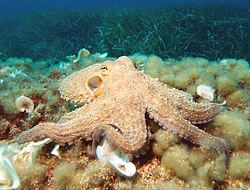
| |
| The Common Octopus, Octopus vulgaris. | |
| Scientific classification | |
| Kingdom: | |
| Phylum: | |
| Class: | |
| Subclass: | |
| Superorder: | |
| Order: | Octopoda Leach, 1818
|
| Suborders | |
| Synonyms | |
| |
The octopus (Template:PronEng, from Greek ὀκτάπους (oktapous), "eight-footed",[1][2] with plural forms: octopuses [ˈɒktəpʊsɪz], octopi [ˈɒktəpaɪ], or octopodes [ˌɒkˈtəʊpədiːz], see below) is a cephalopod of the order Octopoda that inhabits many diverse regions of the ocean, especially coral reefs. The term may also refer to only those creatures in the genus Octopus. In the larger sense, there are around 300 recognized octopus species, which is over one-third of the total number of known cephalopod species.
An octopus has eight flexible arms, which trail behind it as it swims. Most octopuses have no internal or external skeleton, allowing them to squeeze through tight places. An octopus has a hard beak, with its mouth at the center point of the arms. Octopuses are highly intelligent, probably the most intelligent invertebrates. They are known to build "forts" and "traps" in the wild, and for rearranging tanks and burying other animals alive in domestication[citation needed]. For this reason, they are quite notorious among aquarium operators.[3] For defense against predators, they hide, flee quickly, expel ink, or use color-changing camouflage. Octopuses are bilaterally symmetrical, like other cephalopods, with two eyes and four pairs of arms. All octopuses are venomous, but only the small blue-ringed octopuses are deadly to humans.[4]
Biology
Octopuses are characterized by their eight arms (as distinct from the tentacles found in squid and cuttlefish), usually bearing suction cups. These arms are a type of muscular hydrostat. Unlike most other cephalopods, the majority of octopuses – those in the suborder most commonly known, Incirrina – have almost entirely soft bodies with no internal skeleton. They have neither a protective outer shell like the nautilus, nor any vestige of an internal shell or bones, like cuttlefish or squid. A beak, similar in shape to a parrot's beak, is the only hard part of their body. This enables them to squeeze through very narrow slits between underwater rocks, which is very helpful when they are fleeing from morays or other predatory fish. The octopuses in the less familiar Cirrina suborder have two fins and an internal shell, generally reducing their ability to squeeze into small spaces.

Octopuses have a relatively short life expectancy, and some species live for as little as six months. Larger species, such as the North Pacific Giant Octopus, may live for up to five years under suitable circumstances. However, reproduction is a cause of death: males can only live for a few months after mating, and females die shortly after their eggs hatch. They neglect to eat during the (roughly) one month period spent taking care of their unhatched eggs, but they don't die of starvation. Endocrine secretions from the two optic glands are the cause of genetically-programmed death (and if these glands are surgically removed, the octopus may live many months beyond reproduction, until she finally starves).
Octopuses have three hearts. Two pump blood through each of the two gills, while the third pumps blood through the body. Octopus blood contains the copper-rich protein hemocyanin for transporting oxygen. Although less efficient under normal conditions than the iron-rich hemoglobin of vertebrates, in cold conditions with low oxygen pressure, hemocyanin oxygen transportation is more efficient than hemoglobin oxygen transportation. The hemocyanin is dissolved in the plasma instead of being carried within red blood cells and gives the blood a blue color. Octopuses draw water into their mantle cavity where it passes through its gills. As mollusks, octopuses have gills that are finely divided and vascularized outgrowths of either the outer or the inner body surface.
Intelligence
Octopuses are highly intelligent, likely more so than any other order of invertebrates. The exact extent of their intelligence and learning capability is much debated among biologists,[5][6][7][8] but maze and problem-solving experiments have shown that they do have both short- and long-term memory. Their short lifespans limit the amount they can ultimately learn. There has been much speculation to the effect that almost all octopus behaviors are independently learned rather than instinct-based, although this remains largely unproven. They learn almost no behaviors from their parents, with whom young octopuses have very little contact.

An octopus has a highly complex nervous system, only part of which is localized in its brain. Two-thirds of an octopus' neurons are found in the nerve cords of its arms, which have a remarkable amount of autonomy. Octopus arms show a wide variety of complex reflex actions arising on at least three different levels of the nervous system. Some octopuses, such as the Mimic Octopus, will move their arms in ways that emulate the movements of other sea creatures.
In laboratory experiments, octopuses can be readily trained to distinguish between different shapes and patterns. They have been reported to practice observational learning,[9] although the validity of these findings is widely contested on a number of grounds.[5][6] Octopuses have also been observed in what some have described as play: repeatedly releasing bottles or toys into a circular current in their aquariums and then catching them.[10] Octopuses often break out of their aquariums and sometimes into others in search of food. They have even boarded fishing boats and opened holds to eat crabs.[7]
In some countries, octopuses are on the list of experimental animals on which surgery may not be performed without anesthesia. In the UK, cephalopods such as octopuses are regarded as honorary vertebrates under the Animals (Scientific Procedures) Act 1986 and other cruelty to animals legislation, extending to them protections not normally afforded to invertebrates.[11]
Defense
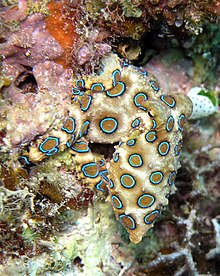
An octopus' main (primary) defense is to hide, either not to be seen at all, or not to be detected as an octopus.[12] Octopuses have several secondary defenses (defenses they use once they have been seen by a predator). The most common secondary defense is fast escape. Other defenses include the use of ink sacs, camouflage, and autotomising limbs.
Most octopuses can eject a thick blackish ink in a large cloud to aid in escaping from predators. The main colouring agent of the ink is melanin, which is the same chemical that gives humans their hair and skin colour. This ink cloud is thought to dull smell, which is particularly useful for evading predators that are dependent on smell for hunting, such as sharks. Ink clouds of some species might serve as pseudomorphs, or decoys that the predator attacks instead.[13]
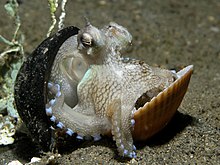
An octopus' camouflage is aided by certain specialized skin cells which can change the apparent color, opacity, and reflectiveness of the epidermis. Chromatophores contain yellow, orange, red, brown, or black pigments; most species have three of these colors, while some have two or four. Other color-changing cells are reflective iridophores, and leucophores (white).[14] This color-changing ability can also be used to communicate with or warn other octopuses. The very venomous blue-ringed octopus becomes bright yellow with blue rings when it is provoked. Octopuses can use muscles in the skin to change the texture of their mantle in order to achieve a greater camouflage. In some species the mantle can take on the spiky appearance of seaweed, or the scraggly, bumpy texture of a rock, among other disguises. However in some species skin anatomy is limited to relatively patternless shades of one color, and limited skin texture. It is thought that octopuses that are day-active and/or live in complex habitats such as coral reefs have evolved more complex skin than their nocturnal and/or sand-dwelling relatives.[12]
When under attack, some octopuses can perform arm autotomy, in a similar manner to the way skinks and other lizards detach their tails. The crawling arm serves as a distraction to would-be predators.
A few species, such as the Mimic Octopus, have a fourth defense mechanism. They can combine their highly flexible bodies with their color changing ability to accurately mimic other, more dangerous animals such as lionfish, sea snakes, and eels.[15][16]
Reproduction
When octopuses reproduce, males use a specialized arm called a hectocotylus to insert spermatophores (packets of sperm) into the female's mantle cavity. The hectocotylus in benthic octopuses is usually the third right arm. Males die within a few months of mating. In some species, the female octopus can keep the sperm alive inside her for weeks until her eggs are mature. After they have been fertilized, the female lays about 200,000 eggs (this figure dramatically varies between families, genera, species and also individuals). The female hangs these eggs in strings from the ceiling of her lair, or individually attaches them to the substrate depending on the species. The female cares for the eggs, guarding them against predators, and gently blowing currents of water over them so that they get enough oxygen. The female does not eat during the roughly one-month period spent taking care of the unhatched eggs. At around the time the eggs hatch, the mother dies and the young larval octopuses spend a period of time drifting in clouds of plankton, where they feed on copepods, larval crabs and larval starfish until they are ready to sink down to the bottom of the ocean, where the cycle repeats itself. In some deeper dwelling species, the young do not go through this period. This is a dangerous time for the larval octopuses; as they become part of the plankton cloud they are vulnerable to many plankton eaters.
Sensation
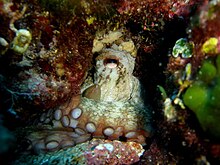
Octopuses have keen eyesight. Although their slit-shaped pupils might be expected to afflict them with astigmatism, it appears that this is not a problem in the light levels in which an octopus typically hunts.[citation needed] They do not appear to have color vision, although they can distinguish the polarization of light. Attached to the brain are two special organs, called statocysts, that allow the octopus to sense the orientation of its body relative to horizontal. An autonomic response keeps the octopus' eyes oriented so that the pupil slit is always horizontal.
Octopuses also have an excellent sense of touch. An octopus' suction cups are equipped with chemoreceptors so that the octopus can taste what it is touching. The arms contain tension sensors so that the octopus knows whether its arms are stretched out. However, the octopus has a very poor proprioceptive sense. The tension receptors are not sufficient for the octopus brain to determine the position of the octopus' body or arms. (It is not clear that the octopus brain would be capable of processing the large amount of information that this would require; the flexibility of an octopus' arms is much greater than that of the limbs of vertebrates, which devote large areas of cerebral cortex to the processing of proprioceptive inputs.) As a result, the octopus does not possess stereognosis; that is, it does not form a mental image of the overall shape of the object it is handling. It can detect local texture variations, but cannot integrate the information into a larger picture.[17]
The neurological autonomy of the arms means that the octopus has great difficulty learning about the detailed effects of its motions. The brain may issue a high-level command to the arms, but the nerve cords in the arms execute the details. There is no neurological path for the brain to receive feedback about just how its command was executed by the arms; the only way it knows just what motions were made is by observing the arms visually.[17]

Locomotion
Octopuses move about by crawling or swimming. Their main means of slow travel is crawling, with some swimming. Jet propulsion is their fastest means of locomotion, followed by swimming and bipedal walking.[18]
They crawl by walking on their arms, usually on many at once, on both solid and soft surfaces, while supported in water. In 2005 it was reported that some octopuses (Adopus aculeatus and Amphioctopus marginatus under current taxonomy) can walk on two arms, while at the same time resembling plant matter.[19] This form of locomotion allows these octopuses to move quickly away from a potential predator while possibly not triggering that predator's search image for octopus (food).[18] Octopuses lack bones and are extremely vulnerable to predators.
Octopuses swim by expelling a jet of water from a contractile mantle, and aiming it via a muscular siphon.
Size
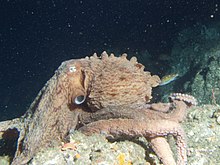
The North Pacific Giant Octopus, Enteroctopus dofleini, is often cited as the largest octopus species. Adults usually weigh around 15 kg (33 lb), with an arm span of up to 4.3 m (14 ft).[20] The largest specimen of this species to be scientifically documented was an animal with a live mass of 71 kg (156.5 lb).[21] The alternative contender is the Seven-arm Octopus, Haliphron atlanticus, based on a 61 kg (134 lb) carcass estimated to have a live mass of 75 kg (165 lb).[22][23] However, there are a number of questionable size records that would suggest E. dofleini is the largest of all octopus species by a considerable margin;[24] one such record is of a specimen weighing 272 kg (600 lb) and having an arm span of 9 m (30 ft).[25]
Terminology
There are three forms of the plural of octopus; namely, octopuses, octopi, and octopodes. Currently, octopuses is the most common form in the UK as well as the US; octopodes is rare, and octopi is often objectionable.[26]
The Oxford English Dictionary (2004 update[27]) lists octopuses, octopi and octopodes (in that order); it labels octopodes "rare", and notes that octopi derives from the mistaken assumption that octōpūs is a second declension Latin noun, which it is not. Rather, it is (Latinized) Greek, from oktṓpous ( ὀκτώπους), gender masculine, whose plural is oktṓpodes ( ὀκτώποδες). If the word were native to Latin, it would be octōpēs ('eight-foot') and the plural octōpedes, analogous to centipedes and mīllipedes, as the plural form of pēs ('foot') is pedes. In modern Greek, it is called khtapódi ( χταπόδι), gender neuter, with plural form khtapódia ( χταπόδια).
Chambers 21st Century Dictionary[28] and the Compact Oxford Dictionary[29] list only octopuses, although the latter notes that octopodes is "still occasionally used"; the British National Corpus has 29 instances of octopuses, 11 of octopi and 4 of octopodes. Merriam-Webster 11th Collegiate Dictionary lists octopuses and octopi, in that order; Webster's New World College Dictionary lists octopuses, octopi and octopodes (in that order).
Fowler's Modern English Usage states that "the only acceptable plural in English is octopuses," and that octopi is misconceived and octopodes pedantic.
The term octopod (plural octopods or octopodes) is taken from the taxonomic order Octopoda but has no classical equivalent. The collective form octopus is usually reserved for animals consumed for food.
Relationship to humans

Ancient peoples of the Mediterranean were aware of the octopus, as evidenced by certain artworks and designs of prehistory. For example, a stone carving found in the archaeological recovery from Bronze Age Minoan Crete at Knossos has a depiction of a fisherman carrying an octopus.[30]
The Moche people of ancient Peru worshipped the sea and its animals; moreover, octopuses were often depicted in their art.[31]
In mythology
The Hawaiʻian creation myth relates that the present cosmos is only the last of a series, having arisen in stages from the wreck of the previous universe. In this account, the octopus is the lone survivor of the previous, alien universe.[32]

As food
Many species of octopus are eaten as food by human cultures around the world. The arms and sometimes other parts of the body are prepared in various ways, often depending on the species being eaten.
Care must be taken to boil the octopus properly, to rid it of slime and the smell, as well as any residual ink.
Octopus is a common ingredient in Japanese cuisine, including sushi, takoyaki, and Akashiyaki. Some small species are sometimes eaten alive as a novelty and health food (mostly in South Korea). Similarly, a live octopus may be sliced up and the legs eaten while still squirming, which they continue to do for some minutes.

Octopus is also eaten regularly in Hawai'i, many of the popular dishes being Asian in origin. Locally known by their Hawaiian or Japanese names, ("he'e" and "tako" respectively) octopus is also a popular catch used as fish bait.
Octopus is also a common food in Mediterranean cuisine and Portuguese cuisine. In Galicia, polbo á feira (fair style octopus) is a local delicacy. Restaurants which specialize or serve this dish are known as pulperías.
According to the USDA Nutrient Database (2007), cooked octopus contains approximately 139 calories per three ounce portion, and is a source of vitamin B3, B12, potassium, phosphorus, and selenium.[33]
As pets
Though octopuses can be difficult to keep in captivity, some people keep them as pets. Octopuses often escape even from supposedly secure tanks, due to their problem solving skills, mobility and lack of rigid structure.
The variation in size and life span among octopus species makes it difficult to know how long a new specimen can naturally be expected to live. That is, a small octopus may be just born or may be an adult, depending on the species. By selecting a well-known species, such as the California Two-spot Octopus, one can choose a small octopus (around the size of a tennis ball) and be confident that it is young with a full life ahead of it.
Octopuses are also quite strong for their size. Octopuses kept as pets have been known to open the covers of their aquariums and survive for a time in the air in order to get to a nearby feeder tank and gorge themselves on the fish there. They have also been known to catch and kill some species of sharks.[34]
Classification

- Class CEPHALOPODA
- Subclass Nautiloidea: nautilus
- Subclass Coleoidea
- Superorder Decapodiformes: squid, cuttlefish
- Superorder Octopodiformes
- Order Vampyromorphida: Vampire Squid
- Order Octopoda
- Genus †Keuppia (incertae sedis)
- Genus †Palaeoctopus (incertae sedis)
- Genus †Pohlsepia (incertae sedis)
- Genus †Proteroctopus (incertae sedis)
- Genus †Styletoctopus (incertae sedis)
- Suborder Cirrina: finned deep-sea octopus
- Family Opisthoteuthidae: umbrella octopus
- Family Cirroteuthidae
- Family Stauroteuthidae
- Suborder Incirrina
- Family Amphitretidae: telescope octopus
- Family Bolitaenidae: gelatinous octopus
- Family Octopodidae: benthic octopus
- Family Vitreledonellidae: Glass Octopus
- Superfamily Argonautoida
- Family Alloposidae: Seven-arm Octopus
- Family Argonautidae: argonauts
- Family Ocythoidae: Tuberculate Pelagic Octopus
- Family Tremoctopodidae: blanket octopus
See also
- Octopus wrestling
- Legend of the Octopus
- Octopus, a Game & Watch game.
- A six-armed octopus, or "hexapus", was found in March 2008 by British researchers.[35] Its subnormal complement of arms was attributed to a birth defect.
References
- ^ Oktapous, Henry George Liddell, Robert Scott, A Greek-English Lexicon, at Perseus
- ^ Scientific Latin from Greek ὀκτώποδ-, ὀκτώπους (also ὀκτάποδ- ὀκτάπους) "eight-footed" > ὀκτώ- or ὀκτά- [combination form of ὀκτώ "eight"] and πόδ-, πούς "foot". Cf. Modern Greek χταπόδι < οκταπόδι < οκταπόδιον < ὀκτάπους.
- ^ [1]
- ^ Tentacles of venom: new study reveals all octopuses are venomous, University of Melbourne, Media Release, Wednesday 15 April 2009
- ^ a b What is this octopus thinking?. By Garry Hamilton.
- ^ a b Is the octopus really the invertebrate intellect of the sea? By Doug Stewart. In: National Wildlife. Feb/Mar 1997, vol.35 no.2.
- ^ a b Giant Octopus—Mighty but Secretive Denizen of the Deep Cite error: The named reference "denizen" was defined multiple times with different content (see the help page).
- ^ How Smart is the Octopus? Slate.
- ^ Octopus intelligence: jar opening
- ^ What behavior can we expect of octopuses?. By Dr. Jennifer Mather, Department of Psychology and Neuroscience, University of Lethbridge and Roland C. Anderson, The Seattle Aquarium.
- ^ United Kingdom Animals (Scientific Procedures) act of 1986
- ^ a b Hanlon, R.T. & J.B. Messenger 1996. Cephalopod Behaviour. Cambridge University Press, Cambridge.
- ^ Caldwell, R. L. (2005). "An Observation of Inking Behavior Protecting Adult Octopus bocki from Predation by Green Turtle (Chelonia mydas) Hatchlings." Pacific Science 59(1): 69–72.
- ^ Meyers, Nadia. "Tales from the Cryptic: The Common Atlantic Octopus". Southeastern Regional Taxonomic Center. Retrieved 2006-07-27.
- ^ Norman, M.D., J. Finn & T. Tregenza (2001). Template:PDFlink Proceedings of the Royal Society 268: 1755–1758.
- ^ Norman, M.D. & F.G.Hochberg (2005). The "Mimic Octopus" (Thaumoctopus mimicus n. gen. et sp.), a new octopus from the tropical Indo-West Pacific (Cephalopoda: Octopodidae). Molluscan Research 25: 57–70. Abstract
- ^ a b Wells. Martin John. Octopus: physiology and behaviour of an advanced invertebrate. London : Chapman and Hall ; New York : distributed in the U.S.A. by Halsted Press, 1978.
- ^ a b Locomotion by Abdopus aculeatus, C.L. Huffard 2006
- ^ Science, vol. 307, p. 1927
- ^ Smithsonian National Zoological Park: Giant Pacific Octopus
- ^ Cosgrove, J.A. 1987. Aspects of the Natural History of Octopus dofleini, the Giant Pacific Octopus. M.Sc. Thesis. Department of Biology, University of Victoria (Canada), 101 pp.
- ^ O'Shea, S. 2004. The giant octopus Haliphron atlanticus (Mollusca : Octopoda) in New Zealand waters. New Zealand Journal of Zoology 31(1): 7-13.
- ^ O'Shea, S. 2002. Haliphron atlanticus — a giant gelatinous octopus. Biodiversity Update 5: 1.
- ^ Norman, M. 2000. Cephalopods: A World Guide. Hackenheim, ConchBooks, p. 214.
- ^ High, W.L. 1976. The giant Pacific octopus. U.S. National Marine Fisheries Service, Marine Fisheries Review 38(9): 17-22.
- ^ Peters, Pam (2004). The Cambridge Guide to English Usage. Cambridge: Cambridge University Press. ISBN 0-521-62181-X, p. 388.
- ^ [2] (subscription required). Retrieved October 22, 2007.
- ^ [3]. Retrieved October 19, 2007.
- ^ [4] Retrieved October 19, 2007.
- ^ C. Michael Hogan. 2007 Knossos fieldnotes, The Modern Antiquarian
- ^ Berrin, Katherine & Larco Museum. The Spirit of Ancient Peru:Treasures from the Museo Arqueológico Rafael Larco Herrera. New York: Thames and Hudson, 199 7.
- ^ Dixon, Roland Burrage (1916). The Mythology of All Races. Vol. 9. Marshall Jones. p. 15.
{{cite book}}: Unknown parameter|subtitle=ignored (help) - ^ Octopus Calories And Nutrition
- ^ Archived Google video of an octopus catching a shark, from The Octopus Show by Mike deGruy
- ^ "Six-legged 'hexapus' claimed as world first in Britain". 2008-03-03. Retrieved 2008-03-03.
External links
- CephBase: Octopoda
- TONMO.COM - The Octopus News Magazine Online
- Tree of Life website: information about cephalopods along with pictures and videos
- Discussion about the plural
- An octopus' shark encounter - footage of an octopus eating a shark (also in Quicktime format)
- Camouflage in action
- Video showing an Octopus escaping through a 1 inch hole
- Bipedal Octopuses- Video, Information, Original paper
- Template:PDFlink
- Video of walking octopuses
